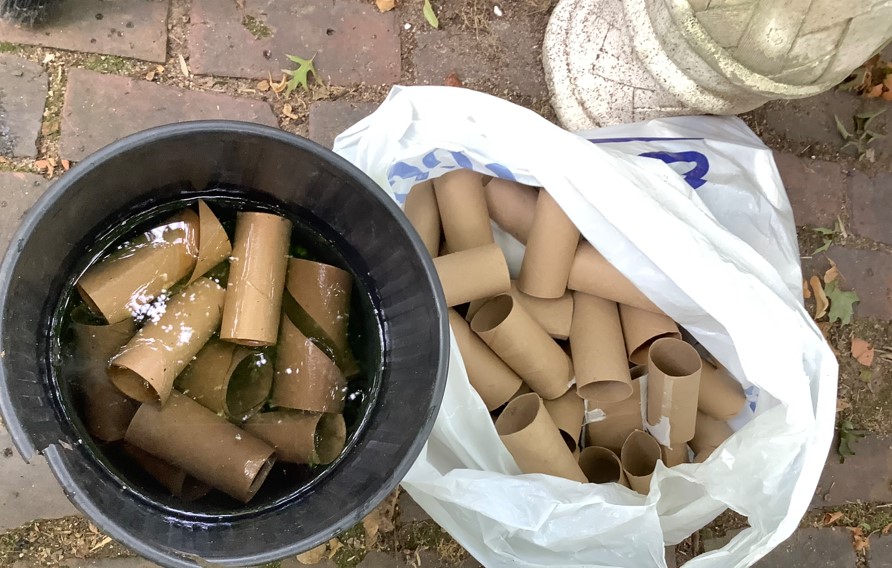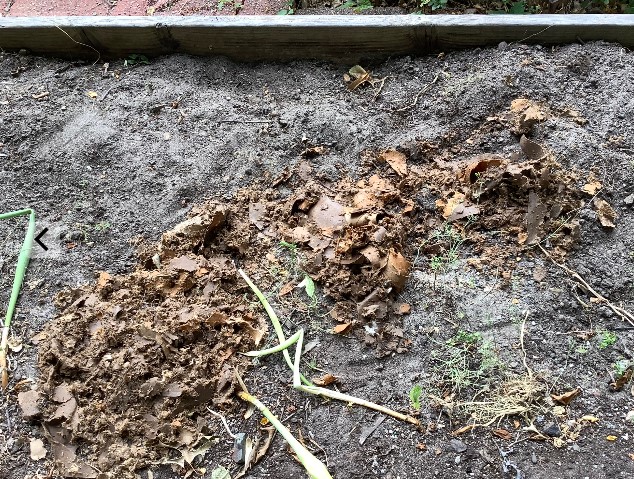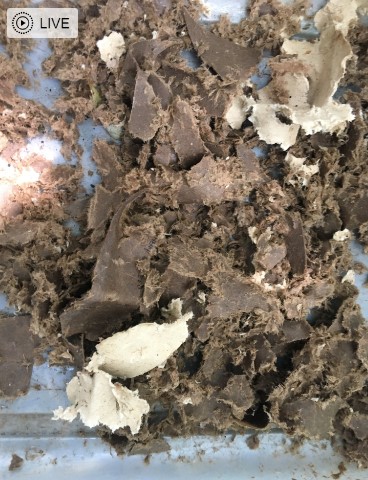Gardening
Related: About this forumWhat I Found Out: Composting Bleach-free Cardboard
I've been saving unbleached paper towel and toilet paper rolls. Everytime a roll is finished, it goes into a bag instead of the recycling. Over the winter, I accumulated a huge bag of such cardboard--about 3' wide and 4' tall. Plus a second bag about a third that size.
Four of my raised beds need organic material, and I was running out of material like leaves. Oh, I could have gone down to my bamboo forest which is loaded with great organic material, but the mosquitoes are thick as thieves and even mosquito repellent doesn't do the job there, so I'm trying to find other materials. It's so important to have that organic material in the soil because otherwise the water just washes straight through. We have a drought here in NJ, so every bit of water saving one can do counts.
But how to shred the cardboard? A web search revealed that plenty of people compost this kind of cardboard, but it appears they actually tear it up themselves. I wasn't about to engage in that much manual labor, so I thought about how I could get these cardboard rolls down to small bits.
The decision was to soak the rolls in water and then use the weedwacker on them.
I filled a few buckets of water half full and put in the rolls. As you can see in the pic below, the cardboard began to soften them almost immediately.

After soaking a bit, I put them in an old plastic tub and used my weedwacker on them. On the bottom of the tub you see the shredded cardboard that resulted from using the weedwacker:

I then transferred the chopped up cardboard to my raised bed, where I'll rake it to spread it around, and then add chopped leaves and whatever other compostable materials I can find.

The soil in these beds is organic and comes mixed with compost. The nursery that delivered it told me that it wouldn't have organic matter and I would have to add that on my own.
Here's what I learned:
1) the bits of cardboard will spatter all over the protector shield of the weedwacker, so have an old rag handy to immediately clean off the cardboard. Otherwise it hardens and would require re-wetting to get it off.
2. The cardboard softens quickly in water, so you can accomplish this task in one work session rather than having to wait for the next step. In all, this job took 45".
3. I was a little surprised at the small yield of material for the amount of cardboard I had. When all was said and done, it did not give me a great deal of organic material to put into the mix. Still, it's a better use of it than what is done in the present state of recycling, so I'll do it periodically.
NJCher
(37,840 posts)This shows the size of the cardboard bits a little better than the photo in my OP:

Quakerfriend
(5,655 posts)It seems that the shredded cardboard would help to keep moisture in the soil - even better than leaf compost.
NJCher
(37,840 posts)You are indeed right. I've been watching it as I mix up the soil, add plants, and water. The cardboard does a good job of absorbing the water and then releasing it over time.
Thanks for the comment!
TreasonousBastard
(43,049 posts)that simply fits over a wastebasket.
If it does 25 sheets of paper, it'll do a towel or toilet roller.
Tetrachloride
(8,445 posts)In my little town, they agreed to deliver to my fields. i received several dozen smallish truck loads. (do not do this in spring because a lot of winter trash)
They also delivered quite a few loads of wood chips. they take 2-4 years to decompose.
wyn borkins
(1,109 posts)I am not a gardener, but I really thought I was 'doing-my-part' by sweeping leaves from the (street) gutter into a dustpan with a silly plastic broom instead of using a leaf blower; I am such a slacker in comparison to your efforts.
...plastic broom sweeping noises, plastic broom sweeping noises...plastic broom sweeping noises...
calimary
(84,278 posts)No need for fuel for the leaf blower. And sweeping gives you exercise!
Btw, I’m intrigued by the composting idea! Toilet paper tubes! Who knew?
I LOVE LOVE LOVE creative recycling!
MiHale
(10,768 posts)Comfrey. This plant is an amazing helper in the garden. It is an excellent organic fertilizer, a compost accelerator, pollination center for bees and well why not it’s a medicinal.
We have five raised beds, about 20 grow bags and various squashes planted in ground along with the expected raspberries and strawberries. And a side project growing a grove of elderberry bushes. Coming this spring building my wife a greenhouse.
All are fertilized with only comfrey used in various ways depending on where it’s being used. We make a liquid comfrey fertilizer by soaking the leaves in a bucket of water for a couple weeks. We use the leavers straight from the plant and lay them directly on the ground around the other veggie plants for mulch and fertilizer together. In the fall when closing up the beds we lay comfrey leave on the ground, cover with soil to ready the beds for the spring.
I also grow organic cannabis inside in a grow tent. To fertilize inside, I chop up the comfrey leaves, dry them and use the resulting “crumble” as a side dressing.
In addition to all that of course it adds biomass to the beds and compost pile. If you go to purchase comfrey make positively sure you get the Russian strain, it’s not the invasive kind.
https://www.tenthacrefarm.com/what-is-comfrey-and-how-to-grow-it/
https://www.masterclass.com/articles/comfrey-plant-guide
Did you know milk is beneficial in the garden?
https://www.gardeningknowhow.com/garden-how-to/soil-fertilizers/milk-fertilizer.htm
![]()
Quakerfriend
(5,655 posts)for comfrey.
mopinko
(71,789 posts)the days of lead and other toxins in printers ink are long gone. it's safe.
i had a huge shredded that did 20 shts of 13" paper. i killed it and have a smaller one, but still enough to do the beer boxes. i try to have a mix of lighter and heavier stuff.
you can just lay down cardboard for mulch and it will be compost by spring.
The Roux Comes First
(1,556 posts)And your creativity!
I have begun to add cardboard, mostly corrugated box stock, to my rotary composter over the last couple months, finally having realized that I was not getting enough of the critical so-called "brown" component in there. We recently moved to a wonderfully lawn-free house, and the large quantities of lawn trimmings I used to rely on are no more.
Admittedly my approach is a bit more labor-intensive than yours, as I tear or cut the cardboard into small pieces, but same idea.